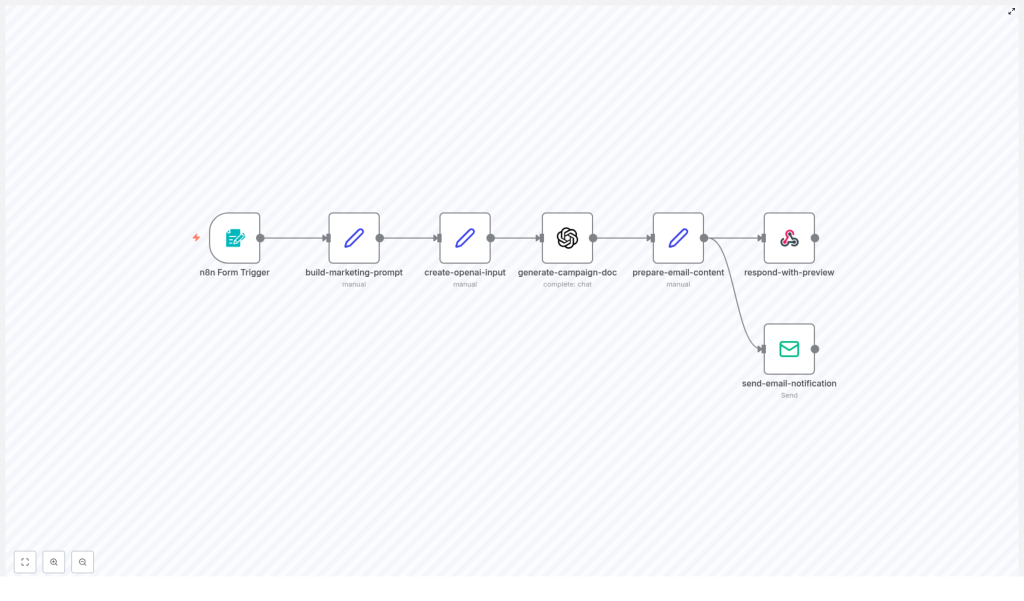Automate Marketing Campaign Documentation with n8n + OpenAI
Turn campaign JSON into concise, actionable documentation automatically. Save time, reduce errors, and keep stakeholders aligned.
Why automate campaign documentation?
Manual campaign documentation is slow, inconsistent, and often out of date. By using an automation pipeline that converts a campaign JSON (from n8n, Zapier, Make or similar) into a clear marketing brief, teams can onboard faster, run experiments with confidence, and hand off work to stakeholders without repeated meetings.
How the automation works (overview)
The workflow in this guide uses n8n as the orchestrator and OpenAI (GPT) to transform campaign JSON into human-ready documentation. At a high level:
- 1) A marketer submits a campaign JSON and metadata through a form.
- 2) n8n builds a controlled prompt and sends the JSON to OpenAI.
- 3) OpenAI returns a concise marketing document in HTML.
- 4) n8n previews the result in the webhook response and emails the documentation to the campaign owner.
n8n node mapping
- n8n Form Trigger — collects Campaign Title, Campaign JSON, and Campaign Owner Email.
- Set (build-marketing-prompt) — assembles a strict instruction prompt to control output style and sections.
- Set (create-openai-input) — injects the title and campaign JSON into the prompt payload.
- OpenAI (generate-campaign-doc) — runs the prompt against a GPT model to generate documentation.
- Set (prepare-email-content) — wraps the generated HTML into an email template and subject line.
- Respond to Webhook — returns a styled HTML preview to the browser.
- Email Send — emails the final documentation to the campaign owner.
1. Campaign Target Audience
Use the automation to clearly define who the campaign is for. The generated doc should include:
- Primary audience: e.g., current customers, new trial users, cart abandoners.
- Audience segments and personas: demographic, behavioral triggers, product fit.
- Recommended filters: last purchase date, engagement score, or tags from CRM.
2. Campaign Goals & KPIs
Each automated brief should list measurable goals and recommended KPIs so teams know what success looks like:
- Primary objectives: acquisition, activation, retention, upsell.
- Key metrics: conversion rate, open/click-through rate (CTR), ROI, engagement, revenue per user.
- Benchmarks: baseline conversion and target lift (e.g., +15% CTR, 3% conversion).
3. Trigger Conditions & Entry Points
Document the exact events that start the campaign, including filters and timing:
- Event triggers: form submission, purchase, trial expiry, time-based schedule.
- Entry criteria: segments, minimum inactivity period, product usage thresholds.
- Scheduling: send window, time zone handling, throttling rules, and retry logic.
4. Message Sequence & Flow
The generated documentation should include a channel-by-channel plan:
- Channel breakdown: email, SMS, push, social ads, or in-app messaging.
- Message cadence: initial touch, follow-ups, escalation, and final attempt.
- Content themes & CTAs: subject line guidance, primary CTA, landing page URL, and personalization tokens.
5. Required Integrations & Credentials
List the systems and keys needed to run and monitor the campaign.
- OpenAI API key (used by the generate-campaign-doc node).
- SMTP or transactional email provider credentials (for send-email-notification).
- CRM/Marketing platform connectors (e.g., HubSpot, Segment, Mailchimp) and API tokens if the campaign syncs segments or events.
- Webhook URLs and any OAuth client IDs/secrets required for third-party API access.
Tip: store keys in n8n credentials and never include secrets directly in prompts or logs.
6. A/B Testing & Customization Guide
Automated docs should recommend variables to test and how to run experiments:
- Test variables: subject lines, preheaders, CTA wording, send times, and imagery.
- Segmentation: split audiences randomly or by cohort (30/70 test, geo-split, or behavior-based splits).
- How to modify variants: keep a naming convention (campaign-v1, campaign-v2) and store variant content as separate JSON objects passed to the automation.
- Optimization: run tests for statistically significant periods (usually 3–14 days depending on traffic) and measure lift on primary KPIs.
7. Setup Instructions
Quick configuration steps
- Install n8n and import the workflow JSON into your instance.
- Configure the Form Trigger node to expose the webhook to your team (set path and form fields).
- Create credentials for OpenAI and add them to the generate-campaign-doc node.
- Configure SMTP or a transactional email service and attach credentials to the send-email-notification node.
- Tailor the set nodes with your brand voice instructions or any corporate-required sections.
Credential setup
- OpenAI: generate an API key and save it in n8n credentials.
- SMTP: user, password, host, port and the from-address (e.g., campaigns@yourcompany.com).
- Optional: analytics or CRM keys for tracking UTM tags and syncing audience status.
Testing checklist
- Submit a sample form entry with a small, representative Campaign JSON.
- Verify the OpenAI node returns HTML and the preview displays in the Respond node.
- Check the email arrives and renders correctly across common clients (Gmail, Outlook, mobile).
- Confirm credentials are not logged in plaintext and rotate keys if you suspect exposure.
Best practices
- Keep prompts strict and repeatable. The clearer the structure you ask for, the more consistent outputs will be.
- Limit the JSON input size or summarize large payloads before sending to the AI to control costs and latency.
- Version your automation and the prompt text so you can roll back if outputs change unexpectedly.
Example: Minimal campaign JSON
{
"title": "Winback - 90 Day Inactive",
"audience": "customers_inactive_90_days",
"channels": ["email"],
"messages": [
{"day": 0, "type": "email", "subject": "We miss you — here’s 15% off", "template": "winback_v1"},
{"day": 3, "type": "email", "subject": "Still there? Special offer expires soon", "template": "winback_v2"}
],
"goals": {"conversion_rate": "2%", "revenue_target": "5000"}
}
Feed the JSON above into the form trigger and the automation will return an HTML brief ready for review and distribution.

